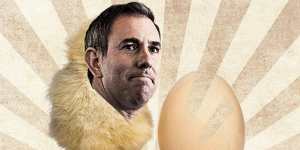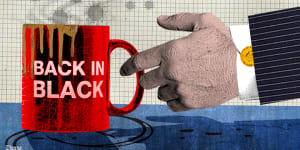That is what happened to Scott Morrison,the current holder of the golden chicken trophy,when he declared with utter certainty that he and his government had delivered a budget surplus.

iStock/Nine
“We will keep the budget in surplus,” Morrison said in a before the 2019 election. “And I can tell you why:because we have brought our budget back to surplus. We’re the party and the government that has done that.”
The debate moderator,Sabra Lane of the ABC,pointed out a troubling fact:“Sorry,it’s not in surplus now.”
Morrison persisted:“I’ve said next year,that’s what I’ve said.”
Lane:“We won’t know that until then.”
Morrison:“I’ve said we brought the budget back to surplus next year.”

Illustration:Dionne Gain
Mangling past and future,he assumed he had already delivered what the budget merely predicted. To be fair to Morrison and the treasurer at the time,Josh Frydenberg,the Coalition whittled away the deficit until it was a rounding error,so the budget was broadly in balance before the pandemic arrived. But facts are facts. There was no surplus.
All governments like to frame their new forecasts as achievements,but the habit leads to bad decisions. At heart,it means the politicians will spend tomorrow’s revenue today. Certain the budget bottom line will improve,they commit to new spending and congratulate themselves on their prudence. All based on a dubious bottom line.
The leading example is the National Disability Insurance Scheme,now forecast to cost $60 billion a year within a few years. Labor committed to this policy in its final budgets before losing power at the 2013 election,and it even produced charts showing the new spending was fully offset by savings. But history shows that the savings didnot fund the policy in full. The spending surged much faster than forecast.
As John Kehoe writes in this week,the cost keeps growing when about 12 per cent of boys aged five to seven are on the scheme.
The NDIS is now the second-biggest federal program after support for seniors with the aged pension and other help. Nobody in government told voters this when the program began. Most in the media,me included,wanted to believe that people could be helped without busting the budget. It is true that many have been helped,but there is a huge challenge in slowing the growth. The cost of the NDIS is now bigger than federal outlays on family tax benefits,JobSeeker and the childcare subsidy. Combined.
Jim Chalmers and Katy Gallagher have avoided the worst of this forecasting danger,so far. The treasurer and finance minister made sure to deliver an upside surprise last year by promising a $4.2 billion surplus in May and turning that into a $22.1 billion surplus in the final budget outcome.
This year’s forecast for a $9.3 billion surplus is highly likely to turn into a bigger surplus as well. Prime Minister Anthony Albanese and Chalmers want to go to the next election after beating their own forecasts.
Yet they have fallen into the old pattern on spending. The policy decisions in last week’s budget will weaken the bottom line by $24.4 billion over four years in the hope of a miraculous improvement in later years. Of the $42.8 billion deficit they expect next financial year,$10.3 billion comes from decisions in last week’s budget.
We know this from the reconciliation table in the budget papers,otherwise known as the “table of truth” by economists. This shows that “parameter variations” outside the government’s control,such as commodity prices,helped to improve the bottom line by $12.6 billion over four years. The deficits would be deeper without these happy assumptions.
And there are good reasons for thinking the bottom line is even weaker than it looks. The Commonwealth has a growing number of off-budget funds,such as the Clean Energy Financial Corporation,the National Reconstruction Fund and the Northern Australia Infrastructure Facility,that treat outlays as investments. A loan,for instance,creates an asset on the federal balance sheet. Labor has pledged about $40 billion to these funds and facilities. (This does not include the National Broadband Network.)
This means the “table of truth” is only a table of half-truths. This grew worse under nine years of Coalition government and seems an irreversible trend.
Gross debt will be $934 billion,or about one-third of GDP,by June next year. It will climb past $1 trillion in the subsequent few years. That offers a reality check for the next time Chalmers talks about being left with $1 trillion of Liberal debt.
Who takes the blame? The debt was about $320 billion in Labor’s last budget before it lost power in 2013. The debt grew under Labor during the global financial crisis and under the Liberals during the next nine years,including the pandemic. How do you divide the total by political party? Where,in that mad calculation,do you assign the interest expense on Labor debt when incurred in Liberal years?
That $1 trillion is stamped with both brands. Incredibly,Labor says at times that it is “paying down” the debt. It is true that the debt may end up being lower in the next few years than previously thought,but that is only a matter of shifting forecasts. The gross debt is still growing every year. So is the interest bill. The net debt,at least,is predicted to fall,thanks to assumptions about the increasing value of Commonwealth assets.
Apologies for labouring the point,but the budget says gross debt will peak at 35.2 per cent of GDP in June 2027,which is one year sooner than the government previously thought. This lulls people into thinking the debt is under control,but the calculation depends on assumptions about the size of the economy. In absolute terms,nobody really knows when the debt may peak and start to fall. The reason? Nobody can say when the budget will return to a structural surplus.
So the interest payments on government securities will grow from $20.9 billion this year to $34.1 billion in four years’ time.
Do not mistake this scepticism about the Labor budget for an endorsement of the Coalition alternative.
The latest promise from shadow treasurer Angus Taylor,that he would restore fiscal rules to balance the books,looks like a pitch to younger voters. That’s because older voters will not be naive enough to believe it. Anyone who has already voted would remember the way the Liberals trashed their fiscal rules when they last held power. Warning about a budget emergency in 2013,they promised to limit spending,allow future revenue gains to fall to the budget bottom line and produce a surplus of 1 per cent of GDP as soon as possible.
They so they could buy elections with tax cuts.
To their credit,Chalmers and Gallagher have produced a surplus,which is more than their predecessors managed. That surplus was almost 1 per cent of GDP,the old Coalition target. If all goes well,they should produce another.
Even so,the budget remains a structural mess. Labor should level with Australians more often about how weak the federal finances really are. All governments want to talk up the brighter parts of their forecasts,of course,but the risk is that they start to believe them. That is when they start counting their chickens.
David Crowe is chief political correspondent.